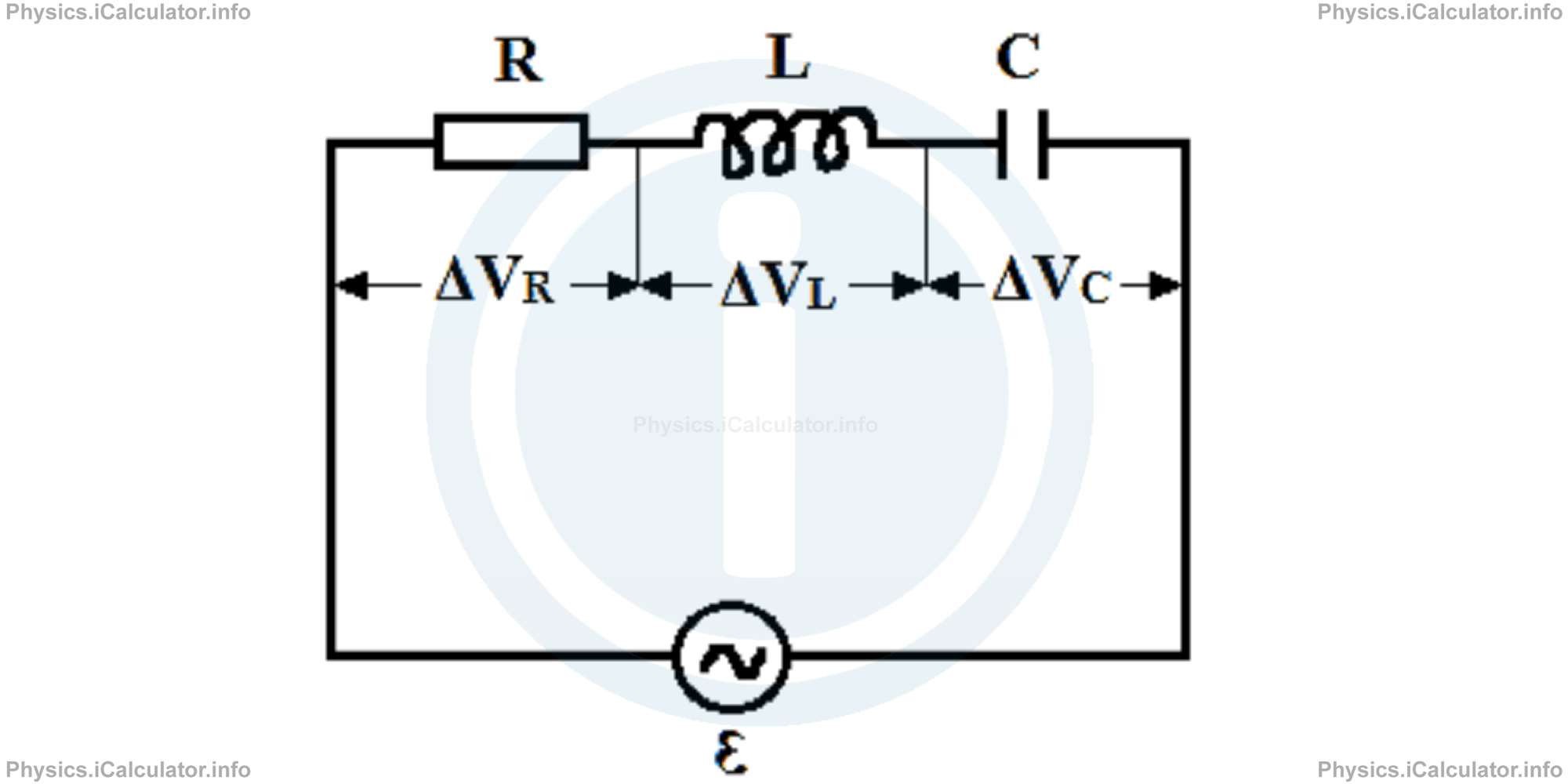Menu
Physics Lesson 16.16.1 - Recap on the Series RLC Circuit
Please provide a rating, it takes seconds and helps us to keep this resource free for all to use
Welcome to our Physics lesson on Recap on the Series RLC Circuit, this is the first lesson of our suite of physics lessons covering the topic of The Series RLC Circuit, you can find links to the other lessons within this tutorial and access additional physics learning resources below this lesson.
Recap on the Series RLC Circuit
As explained in the previous tutorial, a series RLC circuit contains all three elements - a resistor, an inductor and a capacitor - connected in series in the same conducting wire. This means the electromotive force produced by the source produces three separate voltages across each component, as shown in the figure.

We denote the maximum voltages across each component as ΔVR(max), ΔVL(max) and ΔVC(max) respectively.
In the previous tutorial, we have also explained that the current is in phase with voltage only at the resistor; the current in the inductor leads the voltage by one quarter of a cycle (π/2) while in the capacitor, current is behind the voltage by a quarter of a cycle (π/2). Since there is the same current flowing throughout the circuit (i.e. the current is in phase in all components), the maximum voltage produced by the source will not be the arithmetic sum of the three maximum individual voltages, i.e.
This is because voltages are not in phase with each other. However, when considering the instantaneous voltages ΔV(t) for each component, we have
The last equation is always true and you can consider the loop rule to convince yourself about this.
As for the current flowing in the circuit at any instant, we can write
In this tutorial we will explain how to find the current amplitude imax and the phase constant φ, and investigate how they depend on the driving angular frequency ωd. For this, we will use the phasor diagrams, which - as explained in the previous tutorial - represent a simplified version of current and voltage representation, especially in the actual context, where these values change continuously with time.
You have reached the end of Physics lesson 16.16.1 Recap on the Series RLC Circuit. There are 5 lessons in this physics tutorial covering The Series RLC Circuit, you can access all the lessons from this tutorial below.
More The Series RLC Circuit Lessons and Learning Resources
Whats next?
Enjoy the "Recap on the Series RLC Circuit" physics lesson? People who liked the "The Series RLC Circuit lesson found the following resources useful:
- Recap Feedback. Helps other - Leave a rating for this recap (see below)
- Magnetism Physics tutorial: The Series RLC Circuit. Read the The Series RLC Circuit physics tutorial and build your physics knowledge of Magnetism
- Magnetism Revision Notes: The Series RLC Circuit. Print the notes so you can revise the key points covered in the physics tutorial for The Series RLC Circuit
- Magnetism Practice Questions: The Series RLC Circuit. Test and improve your knowledge of The Series RLC Circuit with example questins and answers
- Check your calculations for Magnetism questions with our excellent Magnetism calculators which contain full equations and calculations clearly displayed line by line. See the Magnetism Calculators by iCalculator™ below.
- Continuing learning magnetism - read our next physics tutorial: Power in an Alternating Circuit. Transformers
Help others Learning Physics just like you
Please provide a rating, it takes seconds and helps us to keep this resource free for all to use
We hope you found this Physics lesson "The Series RLC Circuit" useful. If you did it would be great if you could spare the time to rate this physics lesson (simply click on the number of stars that match your assessment of this physics learning aide) and/or share on social media, this helps us identify popular tutorials and calculators and expand our free learning resources to support our users around the world have free access to expand their knowledge of physics and other disciplines.
Magnetism Calculators by iCalculator™
- Angular Frequency Of Oscillations In Rlc Circuit Calculator
- Calculating Magnetic Field Using The Amperes Law
- Capacitive Reactance Calculator
- Current In A Rl Circuit Calculator
- Displacement Current Calculator
- Electric Charge Stored In The Capacitor Of A Rlc Circuit In Damped Oscillations Calculator
- Electric Power In A Ac Circuit Calculator
- Energy Decay As A Function Of Time In Damped Oscillations Calculator
- Energy Density Of Magnetic Field Calculator
- Energy In A Lc Circuit Calculator
- Faradays Law Calculator
- Frequency Of Oscillations In A Lc Circuit Calculator
- Impedance Calculator
- Induced Emf As A Motional Emf Calculator
- Inductive Reactance Calculator
- Lorentz Force Calculator
- Magnetic Dipole Moment Calculator
- Magnetic Field At Centre Of A Current Carrying Loop Calculator
- Magnetic Field In Terms Of Electric Field Change Calculator
- Magnetic Field Inside A Long Stretched Current Carrying Wire Calculator
- Magnetic Field Inside A Solenoid Calculator
- Magnetic Field Inside A Toroid Calculator
- Magnetic Field Produced Around A Long Current Carrying Wire
- Magnetic Flux Calculator
- Magnetic Force Acting On A Moving Charge Inside A Uniform Magnetic Field Calculator
- Magnetic Force Between Two Parallel Current Carrying Wires Calculator
- Magnetic Potential Energy Stored In An Inductor Calculator
- Output Current In A Transformer Calculator
- Phase Constant In A Rlc Circuit Calculator
- Power Factor In A Rlc Circuit Calculator
- Power Induced On A Metal Bar Moving Inside A Magnetic Field Due To An Applied Force Calculator
- Radius Of Trajectory And Period Of A Charge Moving Inside A Uniform Magnetic Field Calculator
- Self Induced Emf Calculator
- Self Inductance Calculator
- Torque Produced By A Rectangular Coil Inside A Uniform Magnetic Field Calculator
- Work Done On A Magnetic Dipole Calculator